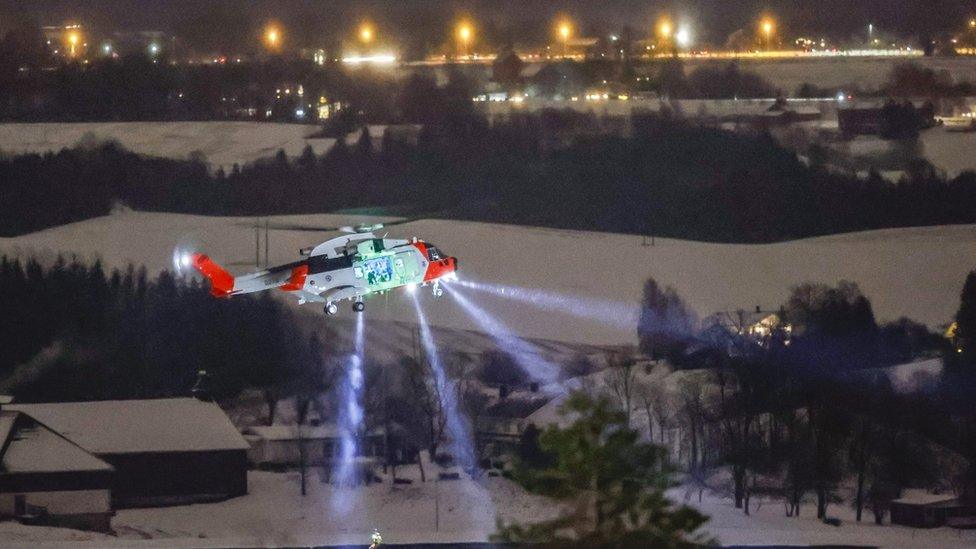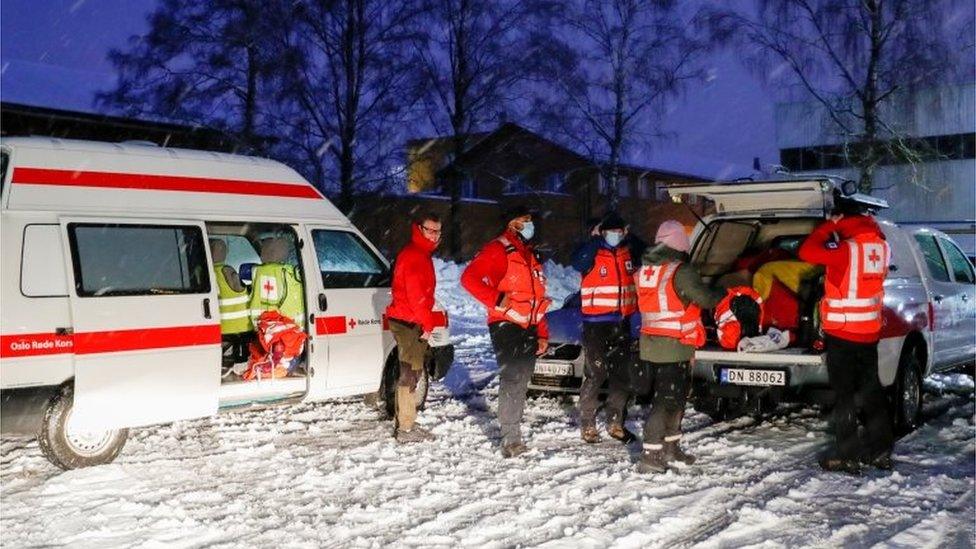Norway landslide: Houses buried in Gjerdrum village near Oslo
- Published
Aerial footage shows the scale of the landslide
A landslide in a Norwegian village has buried homes under dark mud, injuring 10 people - one seriously - and leaving a further 10 missing.
Rescue workers are continuing to search for the missing, who include children, in the village of Gjerdrum, 25km (15 miles) north-east of the capital, Oslo.
Around 1,000 people have so far been evacuated from the village.
Police said some people were feared to be trapped in mud and debris.
"We are quite certain that there are people in the affected area," police spokesman Roger Pettersen told reporters on Wednesday.

The ground around the crater left by the landslide remains too unstable to walk on, officials say
Rescuers used drones and helicopters with heat-seeking cameras to look for signs of life beneath the debris, and a dog was rescued from the scene overnight.
Police also urged people not to set off fireworks for New Year's Eve as these could interfere with the heat-seeking technology.
More than 30 homes have been destroyed, but officials say more could be lost as the edges of the crater left by the landslide are still breaking away. Officials have warned people to stay away from the area.
The conditions have proved challenging, with temperatures dropping to -1C (30F) and the clay ground proving too unstable for emergency workers to walk on.
Instead, emergency workers and search and rescue dogs were lowered by helicopter onto structures believed to be stable enough to stand on.

Rescuers were lowered onto stable structures by helicopter
The landslide began during the early hours of Wednesday, with residents calling emergency services and telling them that their houses were moving, police said.
On Wednesday afternoon two more houses collapsed into the crater formed by the landslide, while others remained perched precariously on its lip.
"There were two massive tremors that lasted for a long while and I assumed it was snow being cleared or something like that," Oeystein Gjerdrum, 68, told broadcaster NRK.
"Then the power suddenly went out, and a neighbour came to the door and said we needed to evacuate, so I woke up my three grandchildren and told them to get dressed quickly."


"There could be people trapped... but at the same time we can't be sure because it is the New Year's holiday, which means people could be elsewhere," Prime Minister Erna Solberg told reporters.
The local municipality warned that up to 1,500 people could need to leave the region because of concerns about the condition of the ground.
A spokeswoman for the Norwegian Water Resources and Energy Directorate (NVE) told AFP that the landslide was a so-called "quick clay slide" measuring about 300m by 700m (985ft by 2,300ft).
"This is the largest landslide in recent times in Norway, considering the number of houses involved and the number of evacuees," Laila Hoivik said.

Quick clay is a kind of clay found in Norway and Sweden that can collapse and become fluid when it comes under stress. However Ms Hoivik said further slides were unlikely.
Broadcaster NRK said heavy rainfall may have made the soil unstable, but questions have since emerged over why construction was permitted in the area.
A 2005 geological survey labelled the area at high risk of landslides, according to a report seen by the broadcaster TV2. Despite this, the homes were built three years later in 2008.
Meanwhile, Norway's King Harald, 83, said the incident had "made a deep impression on me and my family".
"My thoughts are with everyone affected, the injured, those who lost their homes and are now living in fear and uncertainty of the full extent of the disaster," he said in a statement released by the royal palace.
Another landslide struck in the Norwegian town of Alta in June